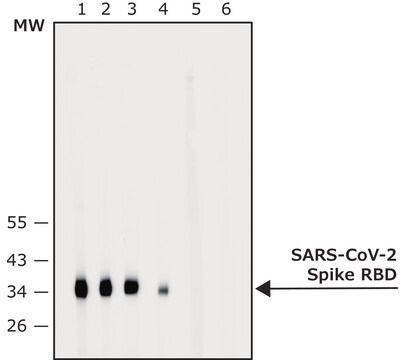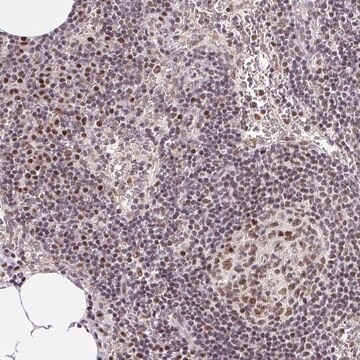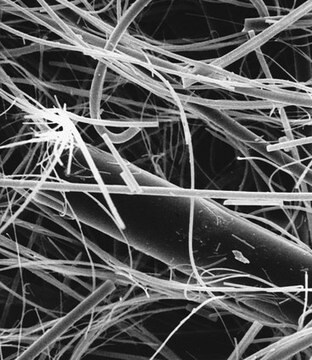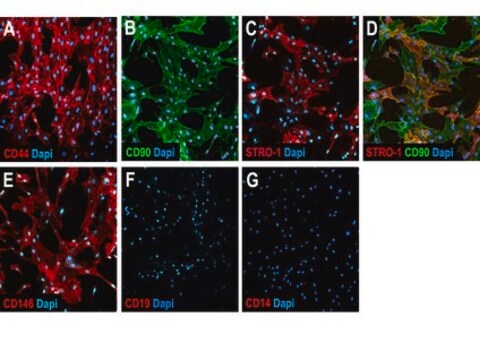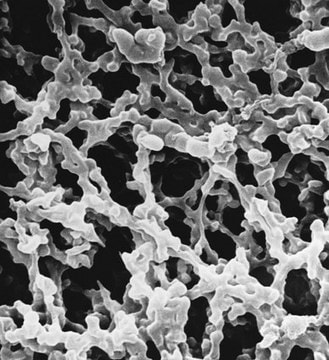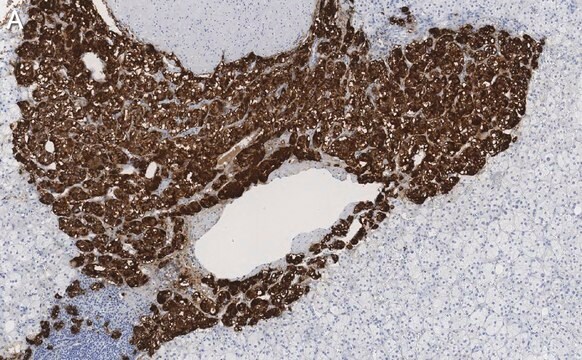推薦產品
生物源
mouse
品質等級
抗體表格
purified antibody
抗體產品種類
primary antibodies
無性繁殖
YL15, monoclonal
物種活性
human, mouse
技術
ChIP: suitable
immunocytochemistry: suitable
immunofluorescence: suitable
immunohistochemistry: suitable (paraffin)
western blot: suitable
同型
IgG1κ
NCBI登錄號
UniProt登錄號
運輸包裝
wet ice
目標翻譯後修改
unmodified
基因資訊
human ... POU2F1(5451)
mouse ... Pou2F1(18986)
一般說明
POU domain, class 2, transcription factor 1 (UniProt P14859; also known as NF-A1, Oct-1, Octamer-binding protein 1, Octamer-binding transcription factor 1, OTF-1) is encoded by the POU2F1 (also known as OCT1, OTF1) gene (Gene ID 5451) in human. Oct-1 belongs to the family of octamer transcription factors characterized by their binding to the ATTTGCAT octamer sequence via their POU domain (a.a. 280-354 of human Oct-1). Oct1 is widely expressed in adult tissues, however, Oct-1 knockdown has little impact on cell growth and viability in culture. Oct-1 controls multiple stem cell phenotypes in normal and tumor cells. Oct-1 promotes resistance to genotoxic and oxidative stresses in stem cells. Loss of Oct-1 antagonizes oncogenic transformation in vitro and tumorigenicity in vivo.
特異性
Clone YL15 targets the POU-domain linker region (Herr, W., and Cleary, M.A. (1995). Genes Dev. 9(14):1679-1693; Lai, J.S., and Herr, W. (1992). Proc. Natl. Acad. Sci. U. S. A. 89(15):6958-6962) present in all six spliced isoforms of human Oct-1 (UniProt P14859). Clone YL15 does not react with Oct-2, Oct-4 or Oct-6 (Maddox, J., et al. (2012). PLoS Genet. 8(11):e1003048).
免疫原
Epitope: POU-domain linker region.
Recombinant full-length human Oct-1.
應用
Anti-Oct-1 Antibody, clone YL15, Cat. No. MAB5434-C, is a mouse monoclonal antibody that detects octamer-binding protein 1 (Oct-1) and has been tested for use in immunocytochemistry, immunohistchemistry (Parffin), Immunoflouroesencece, Western blotting, and Chromatin Immunorecipitation.
Immunocytochemistry Analysis: 5.0 µg/mL from a representative lot detected Oct-1 cellular localization in human A431 and HeLa cells by fluorescent immunocytochemistry.
Western Blotting Analysis: A representative lot detected Oct-1, but not Oct-2, Oct-4, or Oct-6 in various human cell lysates and nuclear extracts (Maddox, J., et al. (2012). PLoS Genet. 8(11):e1003048).
Western Blotting Analysis: A representative lot detected Oct-1 in Burkitt lymphoma cells (BJAB and Namalwa), as well as a panel of six primary effusion lymphoma (PEL) cells (Di Bartolo, D.L., et al. (2009). J. Virol. 83(9):4308-4315).
Immunofluorescence Analysis: A representative lot detected Oct-1 immunoreactivity in paraformaldehyde-fixed human and mouse frozen colon tissue sections by fluorescent immunohistochemistry (Maddox, J., et al. (2012). PLoS Genet. 8(11):e1003048).
Immunohistochemistry Analysis: A representative lot detected Oct-1 immunoreactivity in formalin-fixed, paraffin-embedded human colon tissue sections (Maddox, J., et al. (2012). PLoS Genet. 8(11):e1003048).
Chromatin Immunoprecipitation (ChIP) Analysis: A representative lot detected Oct-1 occupancy at the ORF50 promoter, using stable Oct-2-inducible primary effusion lymphoma (PEL) cell line BC1/Tet-on/Oct-2. The association decreased upon induction of Oct-2 expression and enhanced upon ORF50 transfection (Di Bartolo, D.L., et al. (2009). J. Virol. 83(9):4308-4315).
Chromatin Immunoprecipitation (ChIP) Analysis: A representative lot detected Oct-1 occupancy at the U6 and U1 promoter regions in exponentially dividing HeLa cells (Zhao, X., et al. (2001). Mol. Cell. 7(3):539-549).
Electrophoretic Mobility Shift Assay (EMSA): A representative lot caused a supershift of radiolabeled OCT1 consensus oligonucleotide-bound complex in the nuclear extracts from Burkitt lymphoma cells BJAB and Namalwa (Di Bartolo, D.L., et al. (2009). J. Virol. 83(9):4308-4315).
Immunocytochemistry Analysis: A representative lot detected Oct-1 cellular localization in human diploid fibroblast MRC-5-derived HuS-L12 cells at various population-doubling levels (PDLs), as well as in the corresponding immortalized IML12–4 cells by fluorescent immunocytochemistry (Imai, S., et al. (1997). Mol. Biol. Cell. 8(12):2407-2419).
Immunoprecipitation Analysis: A representative lot immunoprecipitated Oct-1 from HEK293 cell lysates (Lai, J.S., and Herr, W. (1992). Proc. Natl. Acad. Sci. U. S. A. 89(15):6958-6962).
Western Blotting Analysis: A representative lot detected Oct-1, but not Oct-2, Oct-4, or Oct-6 in various human cell lysates and nuclear extracts (Maddox, J., et al. (2012). PLoS Genet. 8(11):e1003048).
Western Blotting Analysis: A representative lot detected Oct-1 in Burkitt lymphoma cells (BJAB and Namalwa), as well as a panel of six primary effusion lymphoma (PEL) cells (Di Bartolo, D.L., et al. (2009). J. Virol. 83(9):4308-4315).
Immunofluorescence Analysis: A representative lot detected Oct-1 immunoreactivity in paraformaldehyde-fixed human and mouse frozen colon tissue sections by fluorescent immunohistochemistry (Maddox, J., et al. (2012). PLoS Genet. 8(11):e1003048).
Immunohistochemistry Analysis: A representative lot detected Oct-1 immunoreactivity in formalin-fixed, paraffin-embedded human colon tissue sections (Maddox, J., et al. (2012). PLoS Genet. 8(11):e1003048).
Chromatin Immunoprecipitation (ChIP) Analysis: A representative lot detected Oct-1 occupancy at the ORF50 promoter, using stable Oct-2-inducible primary effusion lymphoma (PEL) cell line BC1/Tet-on/Oct-2. The association decreased upon induction of Oct-2 expression and enhanced upon ORF50 transfection (Di Bartolo, D.L., et al. (2009). J. Virol. 83(9):4308-4315).
Chromatin Immunoprecipitation (ChIP) Analysis: A representative lot detected Oct-1 occupancy at the U6 and U1 promoter regions in exponentially dividing HeLa cells (Zhao, X., et al. (2001). Mol. Cell. 7(3):539-549).
Electrophoretic Mobility Shift Assay (EMSA): A representative lot caused a supershift of radiolabeled OCT1 consensus oligonucleotide-bound complex in the nuclear extracts from Burkitt lymphoma cells BJAB and Namalwa (Di Bartolo, D.L., et al. (2009). J. Virol. 83(9):4308-4315).
Immunocytochemistry Analysis: A representative lot detected Oct-1 cellular localization in human diploid fibroblast MRC-5-derived HuS-L12 cells at various population-doubling levels (PDLs), as well as in the corresponding immortalized IML12–4 cells by fluorescent immunocytochemistry (Imai, S., et al. (1997). Mol. Biol. Cell. 8(12):2407-2419).
Immunoprecipitation Analysis: A representative lot immunoprecipitated Oct-1 from HEK293 cell lysates (Lai, J.S., and Herr, W. (1992). Proc. Natl. Acad. Sci. U. S. A. 89(15):6958-6962).
Research Category
Epigenetics & Nuclear Function
Epigenetics & Nuclear Function
Research Sub Category
Transcription Factors
Transcription Factors
品質
Evaluated by Western Blotting in HeLa cell lysate.
Western Blotting Analysis: 2.0 µg/mL of this antibody detected Oct-1 in 10 µg of HeLa cell lysate.
Western Blotting Analysis: 2.0 µg/mL of this antibody detected Oct-1 in 10 µg of HeLa cell lysate.
標靶描述
~96 kDa observed.
聯結
Replaces: MAB5434
外觀
Protein G Purified
Format: Purified
Purified mouse monoclonal IgG1κ antibody in buffer containing 0.1 M Tris-Glycine (pH 7.4), 150 mM NaCl with 0.05% sodium azide.
儲存和穩定性
Stable for 1 year at 2-8°C from date of receipt.
其他說明
Concentration: Please refer to lot specific datasheet.
免責聲明
Unless otherwise stated in our catalog or other company documentation accompanying the product(s), our products are intended for research use only and are not to be used for any other purpose, which includes but is not limited to, unauthorized commercial uses, in vitro diagnostic uses, ex vivo or in vivo therapeutic uses or any type of consumption or application to humans or animals.
未找到適合的產品?
試用我們的產品選擇工具.
儲存類別代碼
12 - Non Combustible Liquids
水污染物質分類(WGK)
WGK 1
閃點(°F)
Not applicable
閃點(°C)
Not applicable
分析證明 (COA)
輸入產品批次/批號來搜索 分析證明 (COA)。在產品’s標籤上找到批次和批號,寫有 ‘Lot’或‘Batch’.。
我們的科學家團隊在所有研究領域都有豐富的經驗,包括生命科學、材料科學、化學合成、色譜、分析等.
聯絡技術服務![Anti-OCT-4 [POU5F1] Antibody, clone 7F9.2 clone 7F9.2, from mouse](/deepweb/assets/sigmaaldrich/product/images/307/874/7354f72d-80ee-40a5-b7fa-0590fe6784cc/640/7354f72d-80ee-40a5-b7fa-0590fe6784cc.jpg)


